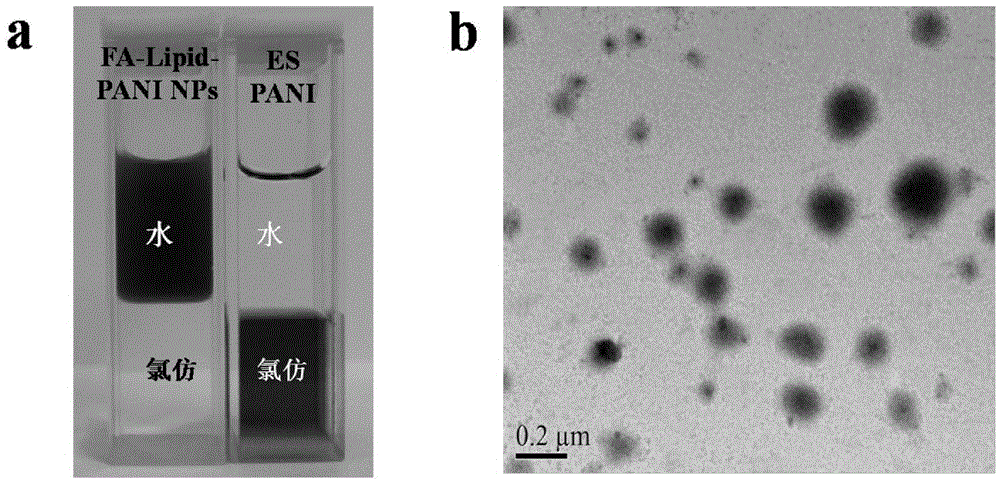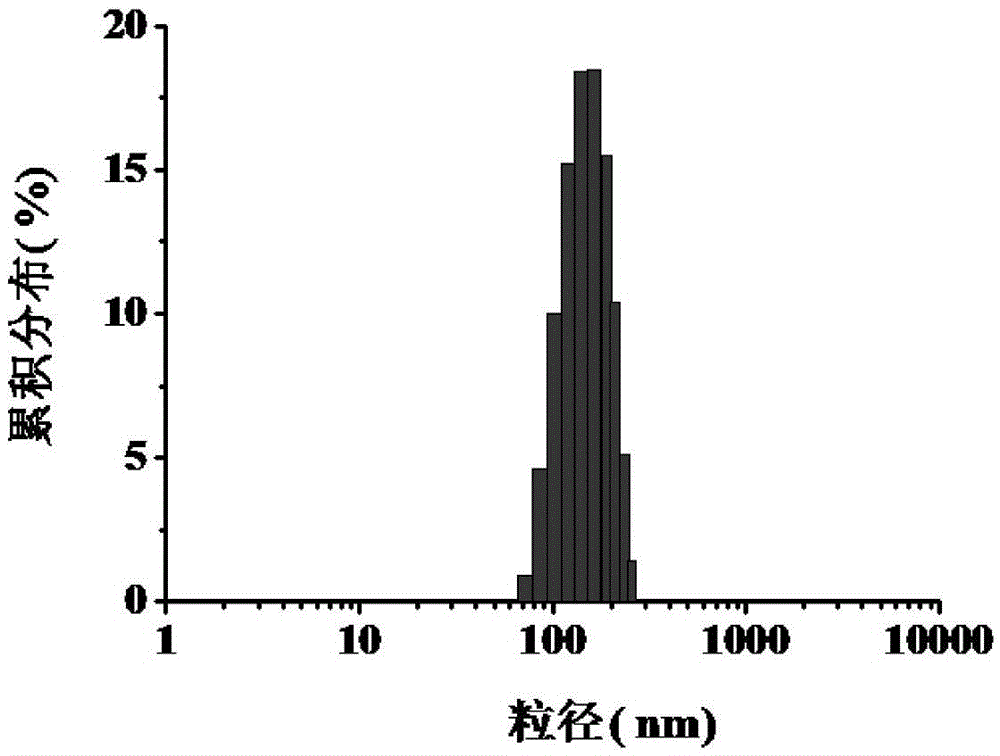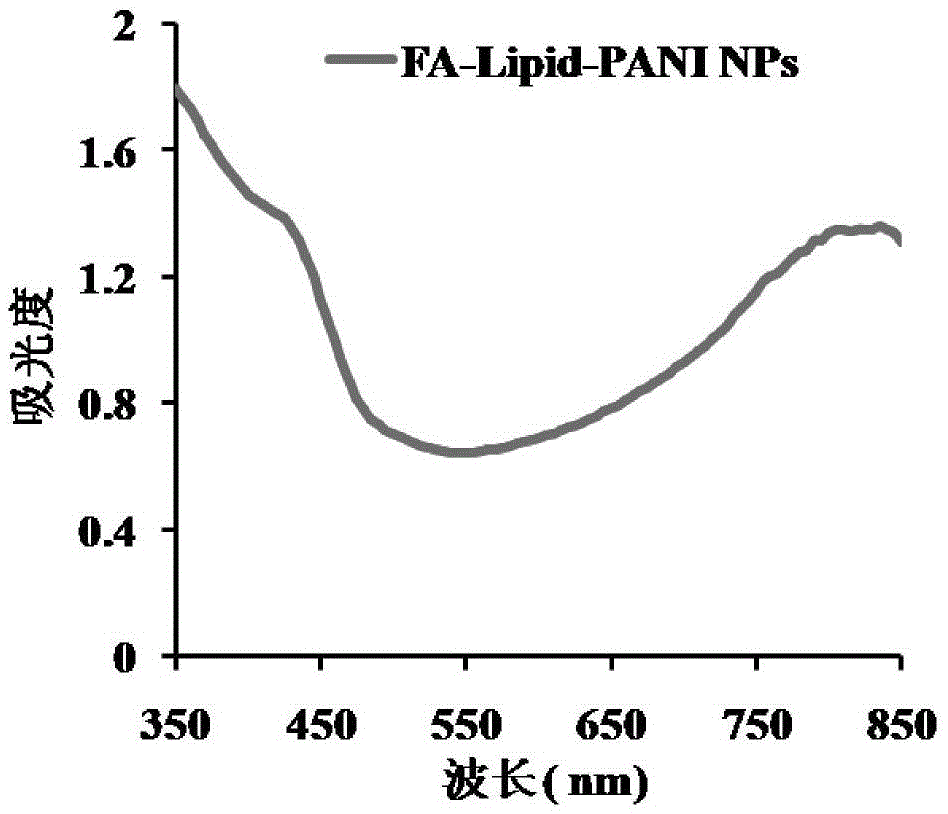Phospholipid-polyaniline nanoparticles for photoacoustic imaging and/or photothermal therapy and preparation method
A photothermal therapy and photoacoustic imaging technology, applied in the field of medicine, can solve the problems of complex preparation process, low biocompatibility, low yield, etc., and achieve the effects of simple preparation method, strong near-infrared absorption, and low energy consumption.
- Summary
- Abstract
- Description
- Claims
- Application Information
AI Technical Summary
Problems solved by technology
Method used
Image
Examples
Embodiment 1
[0037] The preparation of intrinsic state polyaniline: (adopt oxidation polymerization method, this method is reported in the literature)
[0038] Add 0.2mol aniline monomer and 0.3mol concentrated hydrochloric acid to 300mL water to obtain solution a; add 0.1mol ammonium persulfate and 0.2mol concentrated hydrochloric acid to 200ml water to obtain solution b; under stirring, add solution b dropwise to the solution In a, stir at 4°C for 6 hours to obtain a polymer salt solution, which is filtered; disperse all the obtained green precipitates into 500 ml of 1M aqueous sodium hydroxide solution for dedoping reaction, filter, and remove all the obtained purple The precipitate was dispersed into 500 ml of acetone, filtered, and dried under vacuum for 20 hours to obtain purple intrinsic polyaniline powder, which is called EBPANI for short. Gel chromatographic column detection molecular weight 5000.
Embodiment 2
[0040] A method for preparing phospholipid-polyaniline nanoparticles for photoacoustic imaging and / or photothermal therapy, comprising the steps of:
[0041] (1) the intrinsic state polyaniline (the intrinsic state polyaniline is called for short EBPANI) that molecular weight is 5000 is prepared by oxidative polymerization method (see embodiment 1);
[0042] (2) Synthesis of polyaniline nanoparticles wrapped in phospholipids: 5 mg of the intrinsic polyaniline obtained in step (1) and 50 mg of sodium dodecylbenzenesulfonate were dissolved in 8 mL of chloroform; stirred at room temperature for 18 hours to obtain a green Conductive polyaniline solution (conductive polyaniline referred to as ESPANI), 8mL conductive polyaniline solution, 20mL chloroform, 35.2mgDPPC, 5mgDSPE-PEG2000 and 1.4mgFA-DSPE-PEG2000 were added to the container, ultrasonically dispersed for 4 minutes; Evaporate under reduced pressure at 50°C and 120rpm for 25 minutes to remove chloroform, and let stand in vac...
Embodiment 3
[0044] A method for preparing phospholipid-polyaniline nanoparticles for photoacoustic imaging and / or photothermal therapy, comprising the steps of:
[0045] (1) the intrinsic state polyaniline that molecular weight is 5000 is prepared by oxidative polymerization method (see embodiment 1);
[0046](2) Synthesis of polyaniline nanoparticles wrapped in phospholipids: 5 mg of the intrinsic polyaniline obtained in step (1) and 35 mg of sodium dodecylbenzenesulfonate were dissolved in 5 mL of chloroform; stirred at room temperature for 12 hours to obtain a green Conductive polyaniline solution (conductive polyaniline referred to as ESPANI), 5mL conductive polyaniline solution, 20mL chloroform, 35.2mgDPPC, 4mgDSPE-PEG2000 and 1.2mgFA-DSPE-PEG2000 were added to the container, ultrasonically dispersed for 2 minutes; Evaporate under reduced pressure at 40°C and 100rpm for 20 minutes to remove chloroform, and stand in vacuum for 6 hours to remove residual chloroform, add 5mL of water, u...
PUM
 Login to View More
Login to View More Abstract
Description
Claims
Application Information
 Login to View More
Login to View More - R&D
- Intellectual Property
- Life Sciences
- Materials
- Tech Scout
- Unparalleled Data Quality
- Higher Quality Content
- 60% Fewer Hallucinations
Browse by: Latest US Patents, China's latest patents, Technical Efficacy Thesaurus, Application Domain, Technology Topic, Popular Technical Reports.
© 2025 PatSnap. All rights reserved.Legal|Privacy policy|Modern Slavery Act Transparency Statement|Sitemap|About US| Contact US: help@patsnap.com



